5KØK San Andres Island DX Pedition Story
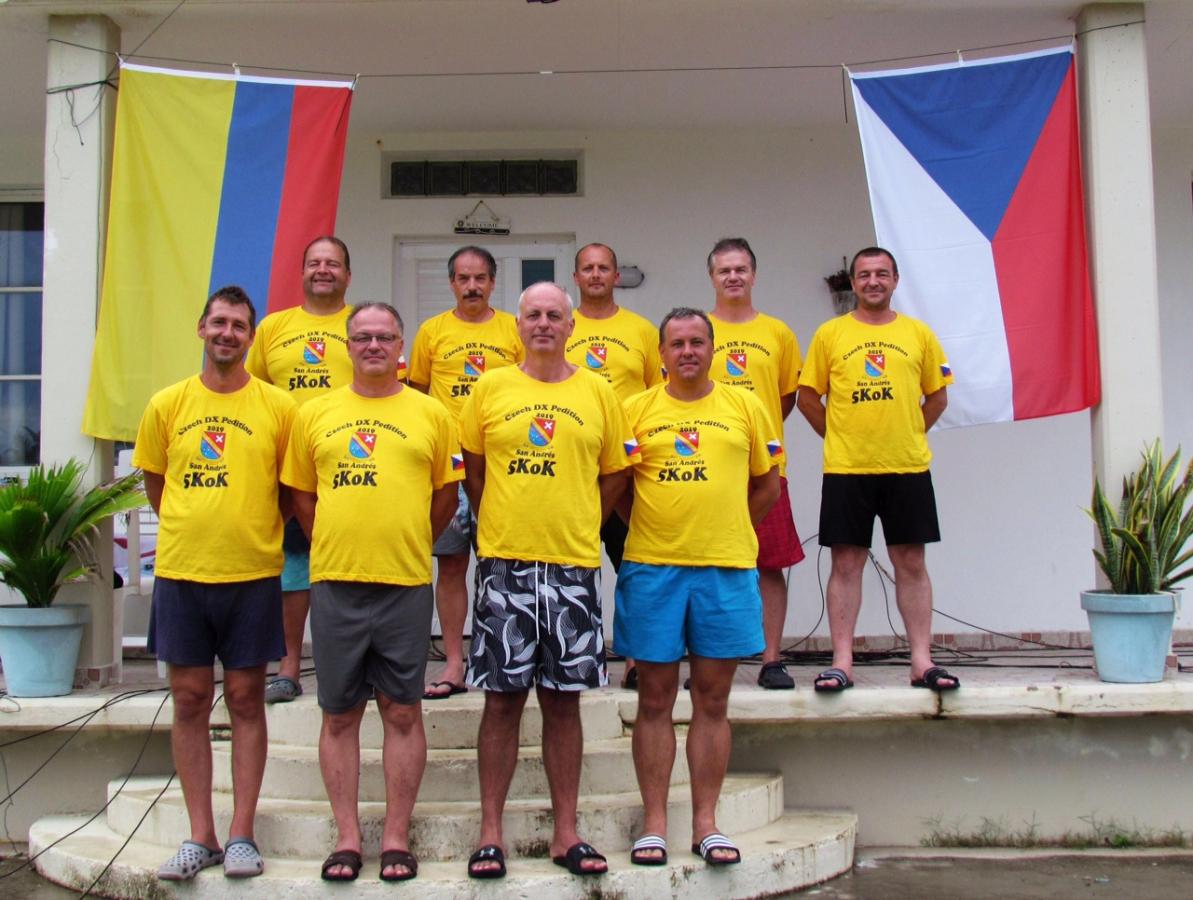 5K0K San Andres Island DX Pedition Team.
5K0K San Andres Island DX Pedition Team.
San Andres (DXCC prefix HK0/A) is an oval, relatively small island (13km long, 3km wide) resembling the shape of a cigar. It lies in the southern part of the Caribbean Sea. Although the nearest mainland is Nicaragua, it belongs to Colombia (a South American country). However, it is paradoxically North American (IOTA NA-033) geographically.
Shortly after returning from the previous DX-pedition to Mayotte we began thinking about a new one. Our original plan was to go to Africa again. We had chosen four DXCC countries and started communication with the relevant authorities. Unfortunately we didn't receive a response from any of the local telecommunication offices of the addressed countries. The contacts from former expeditions didn't work. It was a big disappointment as we hoped that it would be clear where to go before the end of 2018. The solution came suddenly in February 2019 when Karel, OK2ZI had found a special offer forflight tickets from Vienna to Bogota with Turkish Airlines. After checking the availability of domestic flights from Bogota to San Andres, he proposed the DX-pedition to HK0/A as an alternative to Africa. Although HK0/A is not that rare among the DXCC countries, we liked the idea as most of us had never been to the Caribbean and we still could expect a fair amount of interest in our activity. In addition, we choose (with regard to availability of the participants) the date of the expedition for the end of October because it allowed participation in the SSB part of the CQ WW DX Contest. We discussed all of the pros and cons in a quick email exchange on October 21st, and Karel booked tickets for all of the team members the very next day. This started the preparation of the expedition. Some of us immersed ourselves in maps in order to find the best QTH on the island. It was not an easy task considering that we needed a place for eight people and for all of the antennas. Eventually we found a suitable place; a small villa about 200m off the coast with a garden and some space around. We booked it immediately to be sure in case we couldn't find anything better.
We also contacted Rob, HK3CW (the former president of the Colombian Radio Club), and asked for advice concerning the application for the license. Rob was very helpful. He offered full cooperation and sent to us all of the necessary forms. After exchanging some emails we got the idea to invite Rob to participate in our DX-pedition. He agreed enthusiastically to become the ninth group member and proposed joining us in Bogota. That was great as now we had a member who knew all of the local specifics and was a native Spanish speaker (our Spanish is far from fluent).
We also decided to make minor changes in the antenna setup. Instead of the 40m SQ and 30m SQ, we built two couples of phased verticals for each band using the same material. We hoped to erect them at a sufficient distance so it allowed inband traffic on both bands. As we had a bad experience with the SWR of Spiderbeam Yagis we also prepared dual Yagis for the 12m and 17m bands. Their clever design made it possible to mount them either on one boom or as two separate antennas. The last antenna was a light 4 element Yagi for the 6m band. Unfortunately we didn't get the license for the 60m band.
On August 13th we received the confirmation of our call sign 5K0K, and after another two weeks the scan of our license also. Having all of this ready, we presented our upcoming DX-pedition at the DX-forum of the Ham Annual Meeting in Holice. In the meantime we also ordered the expedition T-shirts, designed the logo and created the web site.
On October 5th we had the traditional pre-expedition meeting at Peter's (OK1FCJ) place in Ritka. We made a final check of all of the antennas and equipment and packed the antennas into the oversized bags.
October 10th, the D-day. All team members were supposed to meet at Ruda's (OK2ZA) place in Sudice at 12PM. In the morning the first group with Palo, OK1CRM and David, OK6DJ set out from Ritka, the second group with Petr, OK1BOA and Pavel, OK1GK from Prague. The first problem on our long journey already occured in Czechia. The highway to Brno was closed due to a burning tanker truck. We were late by almost 2 hours, but everybody arrived to Sudice alright, eventually. Ruda's XYL cooked soup and steak for us (TNX Jani). After a late lunch we weighed our luggage and made the final weight redistribution to get all of the pieces under 23kg. The most fragile and valuable pieces, laptops and transceivers, were in our cabin baggage. The total weight of all of the material was over 500kg. The van with a trailer arrived on time to take us to Vienna airport. We got to the airport well in advance despite a broken trailer wheel bearing. It made the passage through Vienna very nerve wracking, though. The following flight to Istanbul took about two hours and went without any problem.
October 15th. Shortly aftermidnight we boarded the flight from Istanbul to Bogota. It took over 13 hours and we landed with a slight delay. Impatiently, we went to pick up our baggage. Fortunately all of the pieces arrived OK, great! There were no problems at customseither, thanks to the carefully prepared documents. We also had the import certificate of all of our material confirmed to avoid any problems when leaving the country. Rob, HK3CW, met us in the arrival hall. After paying tourist taxes required to enter the island, we moved together to the gate for the final flight from Bogota to San Andres. It took another two hours, but we landed on the island on time, all of our baggage as well, unbelievable! We loaded all our stuff in the 3 cars we had booked and moved to our QTH where we arrived at about 4:30PM local time. We immediately started with the QTH inspection. First we met the landlord to discuss the details about the location of our antennas. As promised we were free to build anything in the garden, but entering the neighboring property in the direction to EU was not allowed and the property in the direction to JA was covered with dense jungle, which was not visible from the map or aerial view. The property to the north was a problem, too. Although it looked like a meadow ideal for the antennas on the aerial map it was actually a football field. Palo, David and Rob set out to do some necessary shopping. The rest of us still decided to build some antennas before dark. Despite fatigue we unpacked our five antenna bags and started building our antenna farm. OK1GK and OK2ZC erected 2 element phased verticals for the 40m band in the EU direction. OK2ZA and OK2ZI put up the multiband vertical for 40-15m. OK1BOA and OK1FCJ started to assemble their Spiderbeams, but they didn't complete them before dusk. It was already dark when we put our first two stations with K3 and PA into operation. At 1AM David sat down at the radio and made (traditionally) the first QSO. 5K0K was on air from then on. There was a nice pile up on the 30m band. In a short time OK1FCJ started the operation on the 40m band, too, while the rest of the team was setting up the third station with K3 and PA, and the fourth one with TS480 for FT8. Very soon, however, there was a problem with the mains. Although we drove the PAs only to 500W for openers the light bulbs were dimming a lot in the rhythm of morse. The mains were 110V on the island which made the problem even worse. There was nothing we could do about it at that moment, though. About midnight everybody except for the operators went to bed.
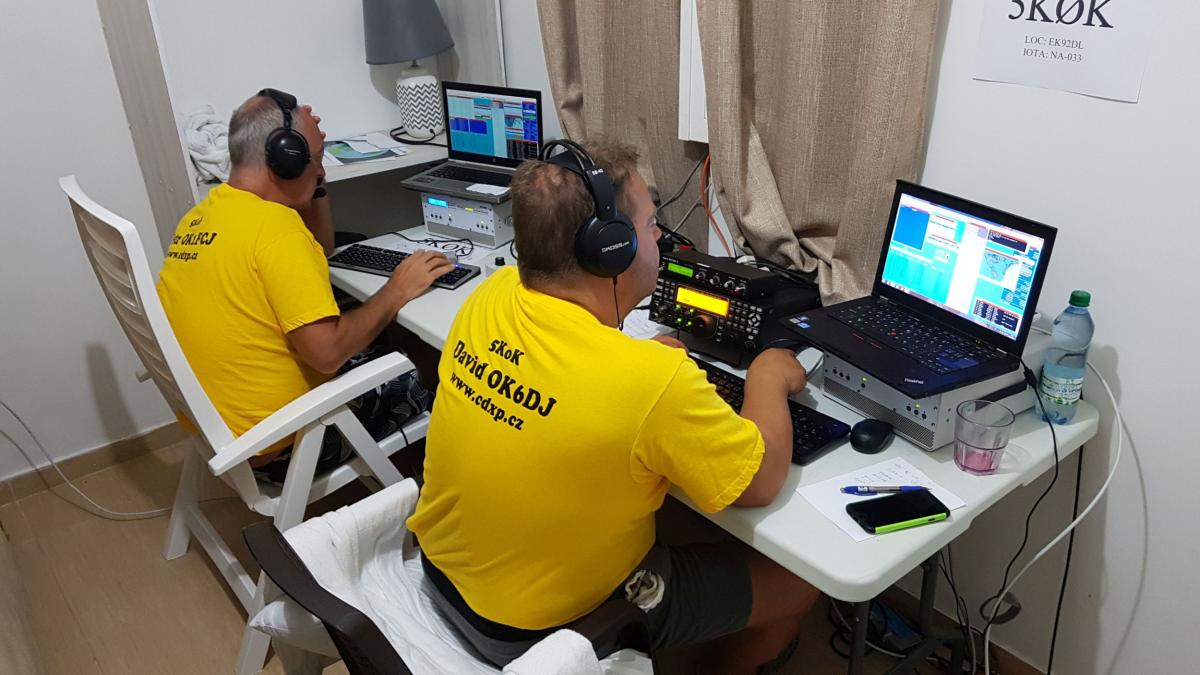 5K0K San Andres Island SSB Camp.
5K0K San Andres Island SSB Camp.
October 16th. We continued on the 30m and 40m bands on CW/SSB throughout the night. Later, when the signals were fading, we switched to FT8. We still got up in the dark to start building antennas at dawn. A hard day awaited us. We built three two-element phased verticals, one for the 40m band in the direction to JA/W7 and two for the 30m band in the direction to EU and JA/W7. Then we put up a 10m mast with 4 elements for the 6m band, 2 elements for the 12m band and 2 elements for the 17m band. Each antenna could rotate independently on the mast. In the afternoon we finally erected all three Spiderbeam Yagis. The one tuned to the SSB part at a 12m height in the garden corner. The other one (tuned to the CW part) at a 10m height in another garden corner. The last one, the “universal” Yagi, at a 14m height on the terrace behind the house. We also managed to agree with the landlord that we could use the space in the clearing between the neighboring properties to erect a quarter wave vertical for the 80m band. We worked very quickly as we were afraid that he could change his mind. The sun was shining all day and the work on the antennas had been very exhausting. Everyone was a little burned, but we were very satisfied with the good SWR of all of the antennas. In in the evening we had four stations on air, but we experienced more problems with the mains. Some devices restarted by themselves from time to time. Sometimes the power supplies in the radios and PAs went offline. Apparently the mains voltage dropped more than we expected.
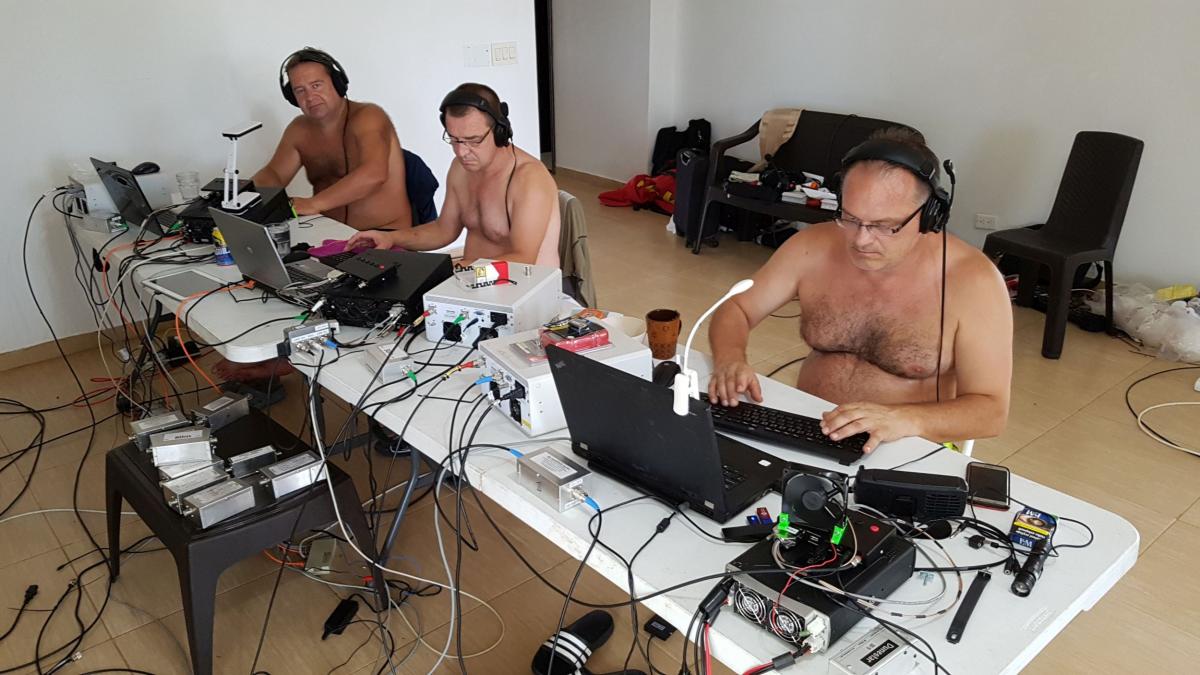 5K0K San Andres Island DX Pedition CW Camp
5K0K San Andres Island DX Pedition CW Camp
October 17th. There were five stations active: three CW, one SSB, and one FT8. We tried the inband traffic on the 20m band. It was possible with a certain combination of antennas. There were no problems on the 15m bandeither, so we could have three stations with CW, SSB and FT8 on this band. Unfortunately this was not the case on the17m. The mutual QRM made the inband traffic impossible there. After lunch we set up another station for FT8. The idea was that every operator could operate two stations at the same time. Towards the evening we erected the last antenna, a quarter wave vertical for the 160m band at the furthest point about 150 meters from the house on the grassy clearing. We were very lucky as a thunderstorm and strong wind came right after we had finished the work. Fortunately all antennas held up, but there was a blackout for several hours which we spent talking with Rob HK3CW. The power supply had been restored late at night so we started working on the lower bands.
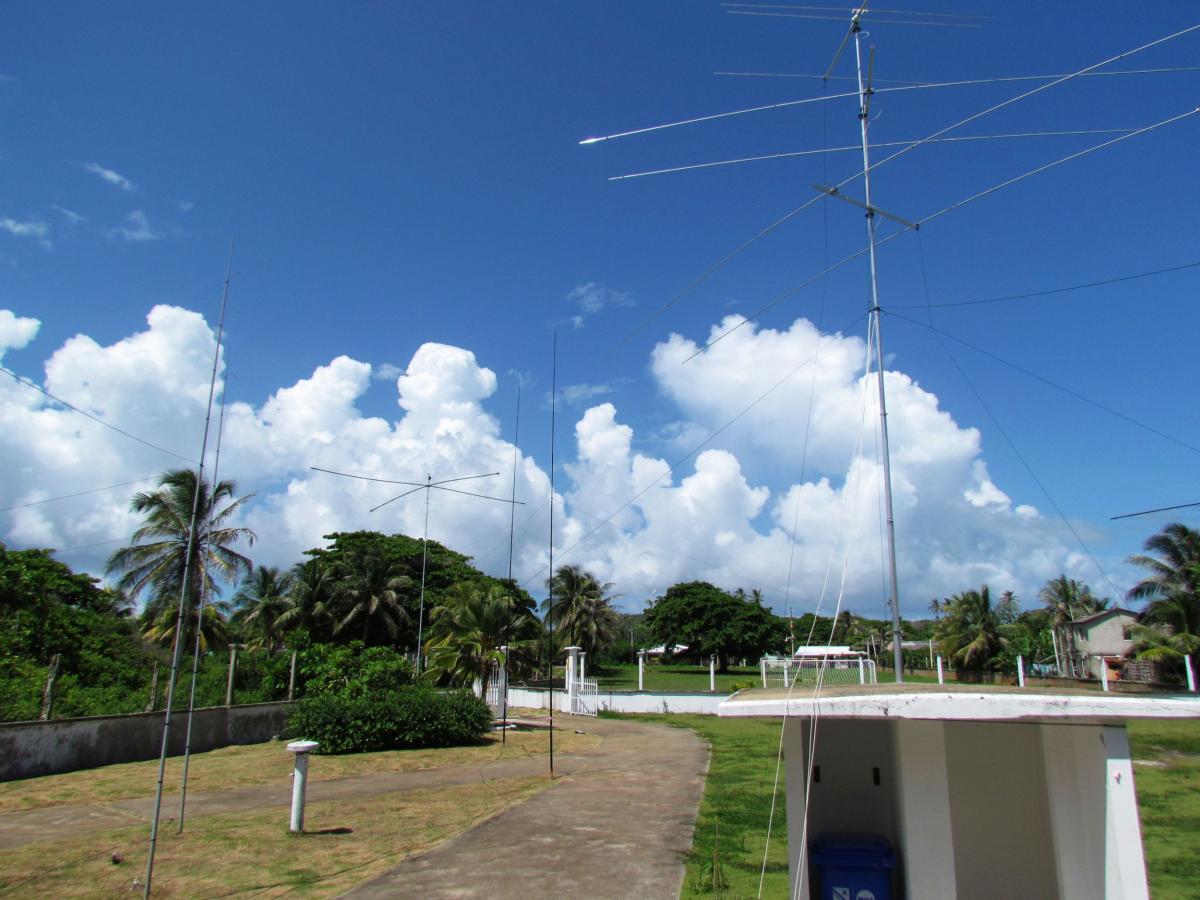
October 18th. We were working on the 40m, 80m and 160m, but the problems with the mains became even worse. Sometimes the voltage dropped down to 80V. We drove the PAs at most to 500W, but they kept going offline anyway. One PA even got broken, but we managed to repair it. In spite of the lower power we felt that the antennas were working very well. We received good reports on all bands. However, to no surprise, RXing on lower bands was poor as we only had verticals so far. The task for today was clear – building the beverage RX-antennas. With the dawn we moved to higher bands where we stayed the whole day. In the afternoon we started cutting lanes through the jungle with a borrowed machete to make place for the beverage antennas. Stretching two 150m wires through the jungle (in the direction of the EU and JA/W7) took several hours, but the benefits were great. We could use them with the 160m to 30m bands. The fight with the vegetation really paid off.
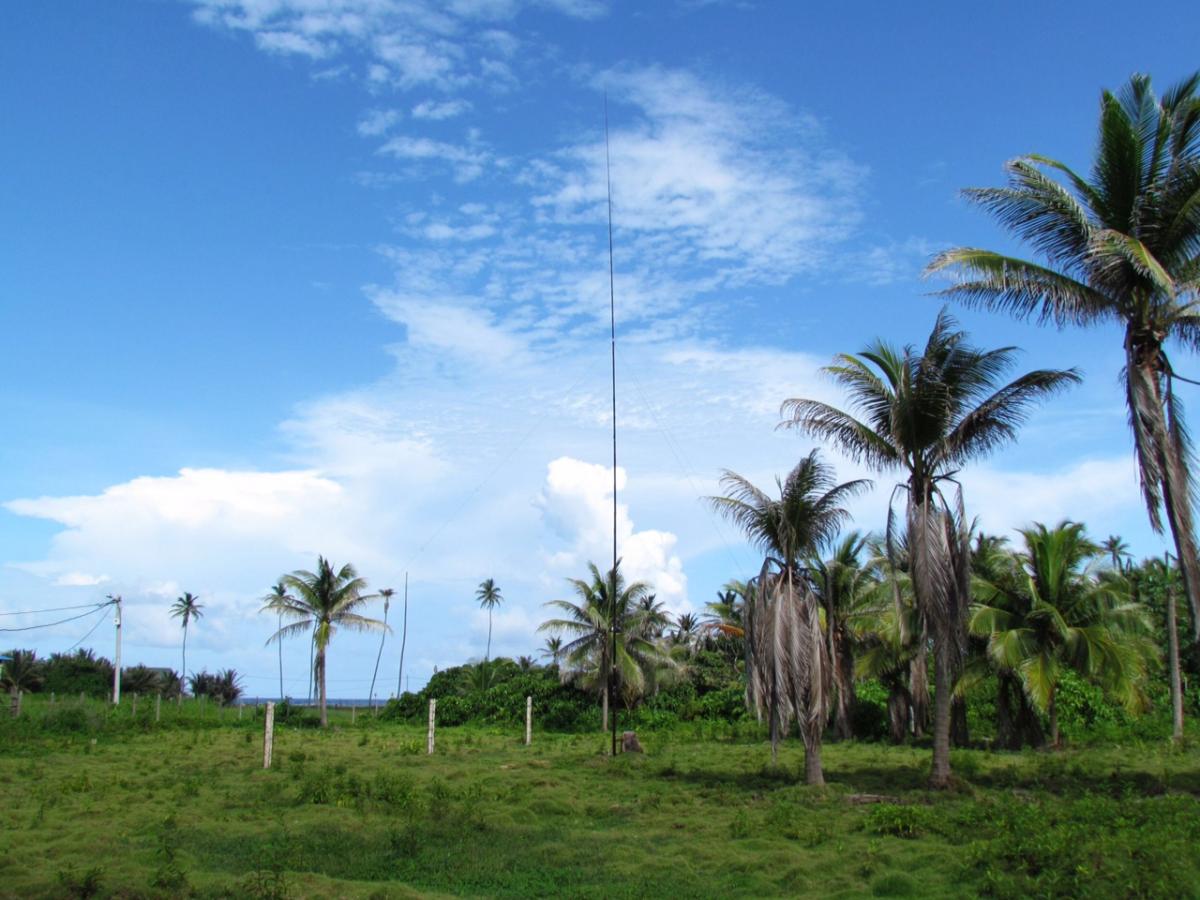
October 19th We focused on the problem with the mains. We made new cables and connected them directly to the switchboard to avoid the poor house wiring. It looked as if it had helped a bit. On this day we also experienced the first short opening on the 10m band. We hoped that the propagation might improve. The guys who weren’t operating any radios at the moment went swimming in the sea, but the local people warned them about sharks and recommended to stay close to the beach. In the afternoon we already had 20000 QSOs in the log, not bad! This gave us hope that we would finally exceed the “magic” number of 50000 QSOs in this expedition.
October 20th We were working on all bands with full commitment. All seven stations were on air, 3 CW, 2 SSB and 2 FT8. The propagation was good in the morning, but around noon it deteriorated for couple of hours. No pile up on CW or SSB, but it didn't apply for FT8. It just confirmed the sad saying: “You can't beat FT8”, which we repeated many times during the expedition. There wouldn’t be as many QSOs in the log today as the previous days. Besides one K3 got broken. Fortunately we had a spare TS480 to replace it. An iguana paid us a visit in the afternoon. We took a couple of shots. It would be a beautiful background for our QSL cards.
October 21st. There were serious problems with the mains the whole night. We had to switch off all air conditioning except for the radio room. Sleeping became very uncomfortable, but there was nothing else we could do. We tried to reconnect all of the equipment and appliances in the switchboard so the load was balanced between two phases. We also checked the grounding, but it seemed even worse after our interventions. Sometimes the voltage even got on the body of our devices somehow and we had to wear gloves to avoid electrical shock when connecting the antenna coaxial cables to PAs. The propagation was very good in the afternoon and it even improved on the 80m and 160m bands after dark. Unfortunately a heavy thunderstorm came in. Although we were very sorry we had to QRT and wait till it stopped. When we were able to continue the good propagation was gone. C'est la vie.
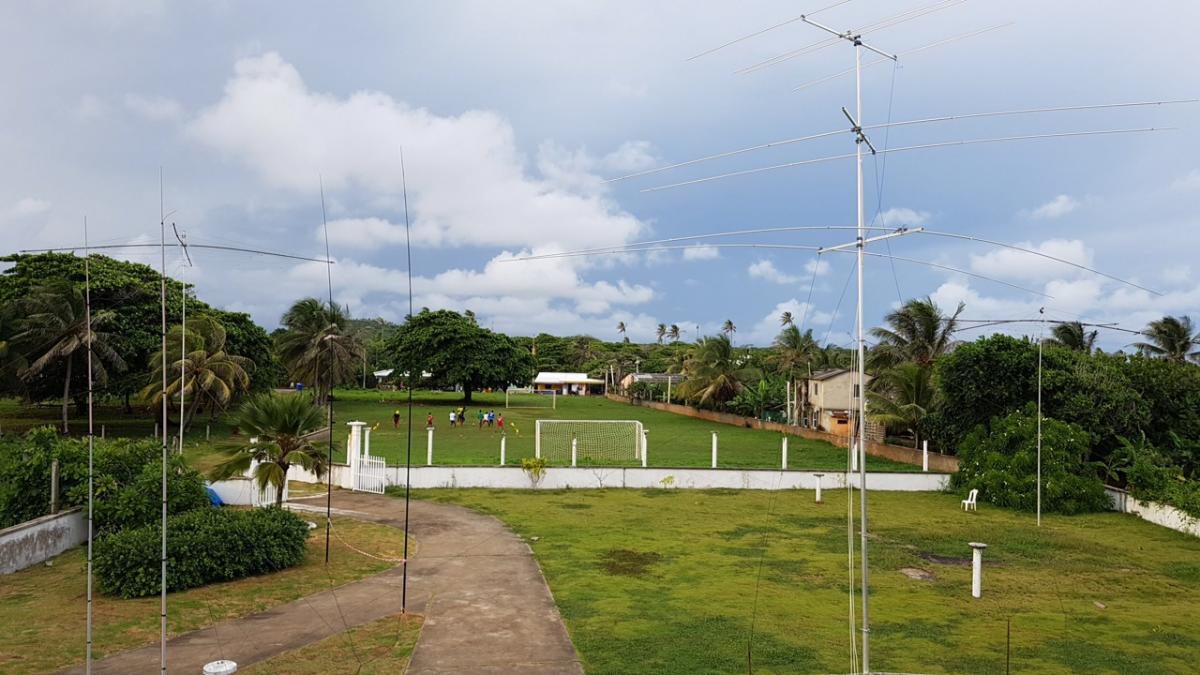
October 22nd. Another PA got broken this morning. It gave only limited power. We were getting nervous as it was still a long time till the end of the expedition and we had already lost two PAs out of five. The major effort of our expedition focused on the lower bands where serious work without PAs is absolutely impossible. The reason for all of the trouble was very likely the undervoltage in the mains. The propagation on higher bands was below average on this day, but we experienced an unexpected opening on the 12m and 10m bands. We tried to make the most of it. We ran on both bands with the rate over 600 QSO/hour. We also tested whether there was any opening on the 6m band, but to no avail.
October 23rd A local ham HK0HF visited us in the morning. He is not active, although he possesses a valid license. We greeted him warmly and Rob HK3CW showed him our stations. The propagation was bad in the afternoon. We weren't able to get a good pile up on any band on CW nor on SSB. We focused on FT8 which works better with weak signals. It was kind of strange. Although we heard a lot of stations S5 to S7 on FT8, no one called us on CW/SSB. We tried it a couple of times in10 minute intervals, but to no avail even if we had spots in the DX cluster. We returned to FT8 where we could keep the rate about 100 QSO/hour.
October 24th. Another blackout in the morning. We had been told that it was due to maintenance and it would last till the afternoon. Therefore we arranged a short trip on the island. We rented some kind of golf cart at one of the many rental offices. Rob guided us around the island in two groups. He had been to San Andres a couple of times before so he could show us the most interesting places. Late in the afternoon the power had been restored and we could continue.
October 25th We achieved the significant goal of 50000 QSOs in the log. We raised a toast with good local rum to celebrate it and sent a message to social networks. We had never made so many QSOs on any of our previous DX-peditions. In addition CQ WW DX Contest was starting tonight so there was a good chance to add a couple of thousands QSO. Some of us believed that we could even exceed 60000. Around noon we tuned the 160m and 80m verticals to the SSB segment of the bands for the contest. The antenna tuning worked great, the SWR was perfect. We also double checked the IARU Region II as well as Colombian national band plans to avoid transmitting out of the allowed segments. Two hours before the contest start we worked only on FT8 to save our ears and voices for the upcoming “Ham Radio Feast”. The CQ WW DX Contest from Caribbean was a premiere and a dream come true for all of us. We choose the M/2 category and made a rooster with 2 hour operating shifts. The contest started for Europeans at unusual time 7PM local. We began on the 15m and 20m, but there were only a few stations on the 15m so we switched to the 40m earlier. The first station from OK – OL1Z had been logged after about half an hour. We ran on the 40m and 80m the whole night. Both bands went very well especially 80m.
October 26th It made no sense to switch to the 160m the first night. We stayed on the 80m and 40m the whole night. Right after dawn we switched to the 20m and 15m. There was a good propagation on both; the 20m was a bit better. Even some rare multipliers, on which we would have to wait a long time in Europe, called us. After all, we were also a multiplier for them, maybe even a double as not many stations were active from the zone 07. One of our stations stayed on the 20m the whole day; the other one switched between the 15m and 10m. There were a lot of stations from South America on the 10m band. Therefore we turned one of the Spiderbeam Yagis in this direction and Rob called in turns English and Spanish. At 7PM half of the contest was over and we had 4400 QSOs in the log. If we could keep this rate it would be a very good result. With the coming night we again switched to the lower bands, and this time also to the 160m, but we only called strong stations and multipliers there.
October 27th. We continued running the contest and the rest of the team worked on WARC bands, mostly on FT8. We focused on the multipliers in the last part of the contest. It was mostly very hard, though, to break through the pile up of big guns having huge Yagis and kilowatts with our low Spiderbeam Yagis and 500W. Nevertheless, we managed to “shoot” some and the score increased satisfactorily. We had also a good pile ups on the higher bands to USA. 7PM marked the end of the contest. We had 7374 QSOs in the log and almost 10 million points. This would be the second best result in zone 07, ever. We could be satisfied. We continued working on the 160m after the contest, but only on FT8 as it wouldn't make any sense to tune the antenna back to the CW segment.
October 28th. We started to dismantle our antennas soon after dawn as we were afraid of the heat, but the weather was friendly to us this time. It was overcast and there was a light breeze throughout the whole day. The departure for the airport was not before the evening so we left two stations on air the whole day. We dismantled our antennas step by step. First the verticals for lower bands, then the Yagis, and in the end the multiband vertical for FT8 already in the dark. The last station went off the air shortly after 7PM local time (12AM UTC). 5K0K was history. There were 64330 QSOs in our log. We packed the last of our baggage. The taxi arrived on time to bring us to the airport. The flight to Bogota went without a problem. The only complication occurred at the Bogota airport. The custom officers didn't like our baggage wrapped up in the plastic foil. We had to cut them and had them wrapped at the local service using the textile foil. After an hour spent with the re-wrapping we eventually managed to check in. This nuisance was followed by the long and weary flight to Istanbul via Panama (16 hours). Then another seven hours waiting at the Istanbul airport and two hours flight to Vienna. Fortunately the van was already waiting for us there. All baggage arrived as well and in another two hours we were in Sudice at OK2ZA’s place where the temperature greeted us at the freezing point. However, Jani's good food (pork and excellent cake) warmed us (again TNX Jani). Everybody took their baggage and we left for our homes the same way we arrived 18 days ago.
Another big ham radio adventure is over. The expedition was a big success. The number of QSOs exceeded all expectations and the contest result was also better than we had hoped for. The antennas worked perfectly. The rig was a bit worse. Fixing all the damaged transceivers and PAs will cost some extra money.
We'd like to thank all hams who made a QSO with us. We believe that for many we were a new DXCC country or at least extra points in the contest. David OK6DJ will take care of the entire QSL agenda. All stations who applied for direct QSL should have confirmation of their contacts in LoTW by now. The QSL cards are being printed and will be available soon.
We'd also like to thank all our sponsors, companies and organizations (DXnews.com, Mastrant, Mediterraneo DX Club, Clipperton DX Club, LA-DX Group, CDXC, Southeastern DX Club, EUDX Foundation, FEDXP Foundation) as well as all our ham friends especially AF3I, HB9JOE, HB9PFM, HP1XT, JA1BK, JA8IUV, JM1ESG, K6JJ, KA5M, KN4NSL, OK2EW, OK1FPG, OK1JR, OK1MY, OK1VK, OK2PDN, OK2PJM, OK5MM, OM5ZX, OM6KW, W6OU, WI9WI. A special thank to Microham company for support and very quick help when setting up the new DXP modems.
Summary:
Time on air: 13 days
Total number of QSOs: 64330
For detailed statistics see: ClubLog.
Rig:
5x Elecraft K3, 3x Kenwood TS480HX, 5x 1kW PA Juma 1000
Antennas:
160m: vertical with capacitance hat on 18m Spiderbeam laminate mast, 10 radials of 42.5 m each on the ground.
80m: quarter wave vertical on 18m Spiderbeam laminate mast, 10 radials of 20m each on the ground
40m: two phased quarter wave verticals on 10m laminate masts from Spiderbeam in EU and JA/W7 directions
30m: two phased quarter wave verticals on 10m DX-wire laminate mast in EU and JA/W7 direction
20m to 10m: three five-band Spiderbeam Yagis at 10m, 12m and 14m height.
12m: 2 el. Yagi at 10m height
17m: 2 el. Yagi at 9m height
6m: 4 el. Yagi at 11m height
RX: two 150m beverages in direction NA/EU and JA/W7.

